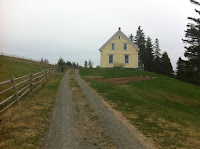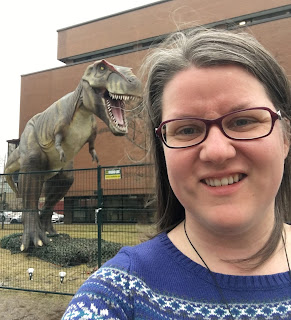Since starting, I’ve had the chance to meet many of you virtually – at the LAMNS conference, at regional meetings, and in working group meetings. I look forward to meeting more of you virtually at more of these meetings. These virtual meetings are great for getting work done but don’t provide the same opportunity to chat and really get to know each other. So, until we can meet in person, let this blog be my informal introduction to you.
First, pour yourself a cup of tea or coffee. I’m a tea drinker, being the daughter of Cape Bretoners. I have been learning to love a coffee though due to some passionate coffee drinkers I’ve been privileged to work with, plus the need for quick caffeine as I try to keep up with my nearly 2-year-old daughter.
I always tell people I’m a museum nerd. As a child I had two major goals in life. First, to live in Nova Scotia. Secondly, to live in a museum. I later changed that to work in a museum. I’ve been lucky. I’ve accomplished these two goals. I grew up in Northern Alberta (Peace River) – in the heartland of oil, farming, and pulp mills. But nearly every summer my parents took us “home” to Cape Breton. When I graduated high school, I moved to Antigonish in pursuit of my treasured x-ring. My mother was sad to see me go so far away to go to university. I told her it was her fault – I grew up thinking of Nova Scotia as home. I was coming home. She understood.
But a desire to make Nova Scotia home wasn’t enough. I wanted a career that embedded me in the culture, people, history, and landscapes of Nova Scotia. So, I got the ever so practical Bachelor of Arts in Celtic Studies, picking up “beagan” (a small amount) Gaelic, in the process, to add to my French. Then, off to Ontario for a year to attend Fleming College’s Museum Management and Curatorship program, before coming back to intern at the Nova Scotia Museum.
My career in museums hasn’t been boring. Definitely not the quiet, peaceful, serene existence younger me envisioned. I’ve worked seasonal, rural sites where I’ve had to track down hundreds of gourds during a pumpkin shortage. I’ve driven a cargo van around the province with boxes of school loans. I’ve worked March Break in the city, talking to hundreds of visitors a day while holding a 5-foot-tall Tyrannosaurus Rex rib bone reproduction. I've completed condition reports on Darth Vader's costume and Luke Skywalker's lightsaber and severed hand. I’ve helped move thousands of artifacts in a three day move, only dropping one lobster trap on my foot (ouch!). I’ve taken part of interpretive planning meetings that turned into singing circles. I even survived the CMA conference study tour to Cape Breton in a May snowstorm. And I’ve worked with so many of you in meetings, working groups, conferences, projects, exhibits, and informal conversations over a good drink, tea or something more appropriate to the situation. It’s all been good (well maybe not dropping the lobster trap on my foot). It’s shown me an amazing, passionate, dedicated field of people who are all doing their best to make museums in Nova Scotia the best they can be.
Despite this positive museum career, I am worried. Museums are at a crossroads. The last few years have shown it to us time after time after time. Museums are traditionally colonial institutions with biases embedded in all their practices that have prioritize the privileged. We need to change. Many museums are seen as great tourist attractions and educational institutions but struggle to become of everyday service to their communities. We need to change. Many museums know they need to address important issues like climate change but just don’t see how that fits into their mandate. We need to change. And so many museums, and museum workers, and museum volunteers, and even museum visitors, are thinking “We are tired – just let us get through Covid-19 and get our feet under us before asking us to do more.” But… we need to change. Now.
These aren’t problems unique to Nova Scotia. Museums around the world are standing at this crossroads together. Museums are Not Neutral. Museums Change Lives. The Coalition of Museums for Climate Justice. Museums as Sites of Social Action. Museum Activism. These aren’t just words. These are real movements. ANSM and museums in Nova Scotia are talking about these movements. We are ready to be a part of them. I hear you say you are ready too when I hear you speak at the recent LAMNS conference, at regional meetings, in working groups, and in informal chats. I hope that in my time at ANSM we can all work together to be this change. Together we will challenge each other and help each other through the rough parts. We will make space for others to join us, and we will listen and learn. And we do it together so that instead of this being one more thing that makes us tired, it is something that makes us stronger, more sustainable, and more representative of Nova Scotia, of home.Well now my tea is cold. I’ve talked too much. And yet I’ve said so little. That’s why these conversations are better over a cold beverage. I hope you feel you know me a bit better. More than that, I hope you trust me a bit more as ANSM is a great responsibility. It is a members-based organization, and I am here to listen to you and be inspired by you. You know where to find me if you want to chat – email, phone, Zoom, ANSM office. Also feel free to follow me on Twitter @MaggiesMuseum where I’m regularly inspired by museums around the world leading the change and looking at cat pictures.










